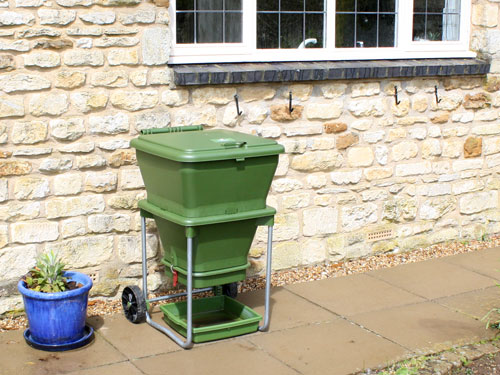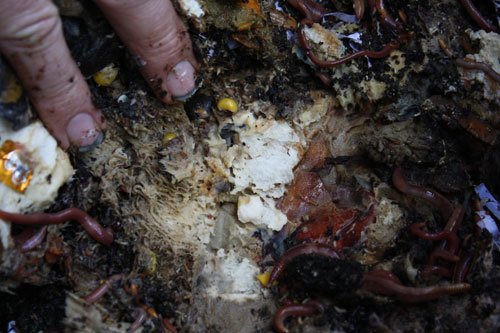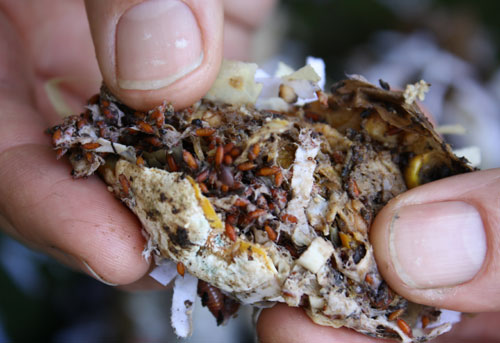No. Your worms will be OK tending to themselves for at least a month if you are going on holiday. They will happily eke out a living from the last food you gave them- just make sure it's a bumper dose. Make sure they are in a place which will keep them above freezing in the winter or out of direct sun in the summer.

No need for a worm sitter when you go away!
Everything but the recent additions should look a bit brown and squishy but not black and mushy. Mould may grow on the contents and this can look anything like a grey beard to a white fluff- it's all quite normal. You shouldn't see many worms, as when you open the lid they should hurry to get out of the light. If they don't then something is out of balance. Check that you are not adding a lot more food to the wormery than usual and check that you have been adding your papery waste regularly. The best solution is to try mixing in lots of scrunched up newspaper with the mushy layers, stirring with a long stick. Sprinkle half a mug full of water over the surface of the mixed contents and leave without feeding for a week. What should my wormery smell like?
Your wormery should smell like a forest floor - the damp leafy type smell you get when you are walking through a wood, if it doesn't then something is out of balance. What is bedding?
Bedding is a woody based material, such as newspaper, shredded printing paper, peat moss, coir-coconut fibre or wood shavings. It is what your worms are delivered in and it's what they like to live in when they are not eating. Worms don't like to live in the rotting food and they also don't like living in their old poo. This is why it is important to keep up your additions of kitchen roll and shredded cardboard etc, so they always have a sanctuary to crawl to. What do I do if my kitchen caddy is suddenly overflowing?
In times of increased food waste, such as Christmas, keep an eye on the waste in your kitchen caddy and make sure that the worms don't get suddenly get overloaded with old mince pies and sprout leaves- they won't be able to deal with it all. It will start to turn to a smelly mush and will ruin the delicate balance your worms have built up over time. You could feed these extras to your chickens. What do I do if everything looks all black and mushy and isn't composting?
This would indicate that perhaps you have had an abnormal amount of scraps to give to your worms recently and they are struggling to keep up. Otherwise it could would be worth checking the wormery temperature, as it could also indicate that the wormery conditions are out of the 15-25° temperature range and the worms have gone into hibernation mode. If this is the case then they wouldn't be eating much. If the temperature isn't ideal then it would be best to move them to an area which is better suited to them. It could also mean that the moisture level is too high.

Too much food can lead to an unhealthy Hungry Bin!
The quick fix is to place loads of sheets of newspaper over the surface of the wormery to soak up some of the excess moisture. This could tend to just dry up the surface layers without effecting underneath, so a more effective solution is to scrunch up lots of newspaper and mix this in with the contents stirring with a large pole. Leave the wormery for a week to regain balance and then resume feeding. What if the wormery is too dry?
Add some water until you achieve the right moisture level, which is just a few drops of water coming out when you squeeze a handfull of their bedding. What if there are lots of small flies in my wormery?
These will be fruit flies. They are harmless, but unfortunately they like all the same foods that your worms like. They best ways of dealing with them are to:
a) Keep a lid on your kitchen caddy and empty it into your wormery more often, so they don't get a chance to breed in the food.
b) Loosely wrap up your scraps in newspaper before putting them in the wormery. The flies have to lay their eggs in rotting vegetable matter and will be put off by the newspaper. Your wormery may need extra water to compensate for the dry paper, but the worms will like the added bedding material.

Fruit flies will lay eggs in rotting food.
Small amounts of chicken poo can be added to the wormery but any other type will be bad for your worms. There are lots of small white things that look like eggs all over my wormery, are these bad?
These are little mites and they move along very slowly. They do no harm and are one of the many other creatures which help along the composting process. Should I worry about rats and squirrels?
You shouldn't have any problems with rodents with furry tails or otherwise, as the wormery is completely sealed and if you have been a good wormery owner and have avoided putting in meat and dairy their will be nothing to attract them to it. Will my worms try to escape? Your worms may try to escape if they have a sufficient colony in the wormery and feel the need to go and colonise somewhere else. They won't be able to escape because the wormery is worm escape proof. In time they will get over their desire to colonise other brave new worlds and will adapt to breeding only when necessary to keep their population stable. Worms crawling up the sides of the wormery in broad daylight is a different more worrying issue - see worm health section for more information about this. Do some worms work better than others?
The worms used for worm composting are different than earthworms. They are surface feeders, not burrowers and are generally smaller. Hungry bin exploits these characteristics as it compresses the castings as they form. This forces the worms to the surface to avoid compaction. This means that you can harvest worms from the bottom without disturbing the lifestyle of the worms living on the surface. In Winter we wrap our existing worm bin in bubble wrap to keep it warm. Is this still needed with the new worm bin?
If the bin is subjected to a long period of cold temperatures it will slow them down, and yes wrapping them with an insulating blanket will be a good idea if you want to keep them in good health. If I was unable to move the hungry bin indoors in winter what would happen? Would it harm the worms or just stop them producing compost?
Your worms would love it if you brought them inside. While they can cope with a wide range of temperatures, they like a moderate, even temperature to be at their best. What's the mix of tiger worms to dendrobaena and are they natives of the UK or of New Zealand?
It looks to me to be about 50/50. I think that the balance will change over time depending on the makeup of the waste stream that you are feeding them. The worms are actually natives of Europe, but were transported all over the world by the original farmers from Europe / UK who understood how important they are to improving soil quality. How do the worms stay out the compost?
The worms are encouraged to the surface by the compression the taper shape of the bin creates. You will get some worms in the finished compost, as some egg casings will have hatched lower down in the bin. Also when you start the bin, the material in the bin is not compressed, so the worms can burrow down looking for goodies. This means the first few lots you get may have some more worms present than you would normally expect. This is not a problem as the lid can be turned upside down and used as a sorting tray. Place the compost on the lid and leave for 5 - 10 mins. Worms don’t like the light, and they are terrified of blackbirds so they go down as fast as possible. This makes it very easy to separate them from the finished compost. Is it ok to add hen droppings to the compost as well as kitchen waste and will this make the compost more alkaline?
It is totally fine to add chicken droppings to the hungry bin. You will need to be careful if you add large amounts as chicken manure is very rich in Nitrogen. I would suggest if you were to add the shavings with the droppings, it will help balance the Carbon / Nitrogen ratio and prevent smells. How do the worms produce more offspring? And how many can be born at a time?
The worms produce egg capsules that look like a grape seed. Each one will have up to 6 babies inside which hatch out after a couple of weeks. I won’t describe the process of creating the egg as this is a family show! Could the normal worms from the garden be added to the Tiger Worms and Dendrobaena worms that can be supplied by Omlet?
You can add worms from your garden as long as they are compost worms and not earthworms. Compost worms are found in mulch and compost piles, manure etc. If you dig a worm out of the soil, it’s likely an earthworm, which is the wrong kind. Does the bin reach a saturation point with regard to worms?
The worms will breed to match your food supply. They regulate their numbers and size to match the conditions. If only humans were so clever! Can you put cotton/ denim clothing in the wormery?
Yes absolutely. You can put anything in there that was once alive. A leather riding jacket or patent leather shoes will take some time to break down though... What are the benefits of this type of compost over a regular type?
The whole idea of the Hungry Bin is to make the process as easy and convenient as possible. Hungry bin is designed for exactly your situation, you don’t have to handle the worms at all. If you’re feeling really squeamish about them, you could get a friend or neighbour to harvest the castings when that needs doing. What is the average life expectancy of the worms?
The worms will live for up to three years depending on the species, which is a pretty long time for such a small critter! Does the wormery get smelly?
The worms like to eat the food when it has gone soft, but before it rots. This is why it doesn’t smell. Usually, if it’s starting to smell, it means it’s either getting over fed, or it needs a little more fibrous material added. (Dried leaves, shredded paper, sawdust, grass clippings etc) How do I stop ants getting climbing into my worm bin?
Generally we don’t have a problem with ants as the food in the hungry bin is kept moist by the condensation, which the ants don’t like. If you have ants from outside appearing, you can put a smear of vaseline on each leg, which they can’t get over... I use compostable liners in my compost caddy as it makes it easier to empty and keep clean. Can you still use these in the Hungry Bin?
Yes, absolutely. Just make sure that the bag is split once you put it in the hungry bin. Our commercial clients all use this system, and we make sure the cleaning staff know to split the bag when it is put in the bin. The liner won’t break down as fast as the food waste, but by the time it makes it through the hungry bin system, it should have broken down completely. Is there are any recycled waste you should not put in your worm farm?
The worms will eat almost anything organic. I would steer away from large amounts of any kind of dairy products or meat, as they break down and smell before the worms can eat it. They are like us, they like anything in moderation. How much would the Hungry Bin weigh when full?
They weigh about 90 kilos when they are full to the brim, and saturated with moisture. They are surprisingly easy to move when they are full, we have some photos of people moving the bin on our website. If the early bird catches the worm, then what does the early worm catch?
The early worm gets to chew on your food waste before the others and turn it into the most amazing fertiliser there is.... Avocado is a favoured food, so I guess that would be considered nirvana in the worm world.... How many worm castings to you harvest from one worm bin a year?
You can harvest castings on average of about every 2 - 4 months. This will depend on the worm population you have in the bin, and the makeup of the waste stream you are putting in. If the bin is running at absolute full capacity, you may get a block of casting every month or so. Would I just be able to move a good clump of worms from my existing compost bin to the Hungry Bin?
Yes you can use the worms you have in your existing compost bin. You can also start the bin with the compost that you have produced, which is an advantage, as the compost will have a lot of the beneficial microbes and bacteria already present (and a lot of worm eggs too, hopefully).
Comments
Ash, 20 May 2020
Wow :) This is an incredible collection of ideas! Waiting for more helpful pieces. You would amazing to read a similar one here- Batterymodeon
George, 23 March 2020
The liquid that drains from my worm farm has hundreds of tiny white things(?) floating on the surface. Any idea what this may be?
Matt, 28 November 2018
Hi there We are in Sydney. We seem to have a happy farm but I’ve never harvested casings in over a year. After heavy rains I’ve have to drain out the bottom level. Generally there is ample moisture in the farm. I gets a couple of hours of direct sunlight per day. We top farm up once a fortnight with a 6 litre container of scraps. But no casings are stopping down. Puzzled. Matt
Roger, 9 September 2016
Have just recieved my first supply of worms and added them to my wormery. How long do I wait before feeding and is it a good idea to add food that has started to rot down or should I only add fresh food such as chopped up fruit and veg etc?